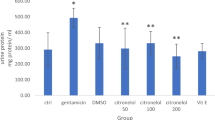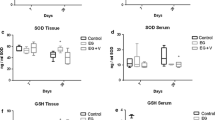Abstract
Many damages can occur in the kidneys following extracorporeal shock wave lithotripsy (SWL) and some of these damages are thought to emerge as a result of oxidative stress. The objective of this study is to evaluate the impact of SWL application on kidneys in stone patients on oxidative stress parameters in 24-h urine. The study included 20 patients scheduled for SWL. total antioxidant capacity (TAC) and total oxidant status (TOS) measurements were made on 24-h urines of the patients before and after SWL. The oxidative stress index (OSI) was calculated based on these values. Following SWL, while TOS increased in 24-h urine (p = 0.006), TAC remained unchanged (p = 0.312). OSI increased following the procedure (p = 0.004). SWL application disrupts the oxidant/antioxidant balance in favor of oxidants, which leads to oxidative stress. TOS, TAC and OSI may be useful in the determination of the existence of oxidative stress following SWL.
Similar content being viewed by others
References
Menon M, Resnick MI (2005) Urinary Lithiasis: Etiology, diagnosis and medical management. In: Walsh PC, Retik TA, Vaughen ED (eds) Campbells urology, vol IV, 8th edn. W. B. Saunders Co., Philadelphia, pp 3229–3293
Matlaga BR, Assimos DG (2002) Changing indications of open stone surgery. Urology 59:490–494
Chaussy C, Schmiedt E (1984) Extracorporeal shockwave lithotripsy (ESWL) for kidney stones. An alternative to surgery. Urol Radiol 6:80–87
Rassweiler JJ, Renner C, Chaussy C et al (2001) Treatment of renal Stones by extracorporeal shockwave lithotripsy: an update. Eur Urol 39:187–199
Fischer C, Wöhrle J, Pastor J et al (2007) Extracorporeal shock-wave lithotripsy induced ultrastructural changes to the renal parenchyma under aspirin use. Electron microscopic findings in the rat kidney. Urologe A 46:150–155
Sarıca K, Koşar A, Yaman O et al (1996) Evaluation of ischemia after ESWL.Detection of free oxygen radical scavenger enzymes in renal parenchyma subjected to high-energy shock waves. Urol Int 57:221–223
Weber C, Moran ME, Braun EJ et al (1992) Injury of rat renal vessels following extracorporeal shock wave treatment. J Urol 147:476–481
Blomgren PM, Connors BA, Lingeman JE et al (1997) Quantitation of shock wave lithotripsy-induced lesions in small and large pig kidneys. Anat Rec 249:341–348
Willis LR, Evan AP, Connors BA et al (1996) Effects of extracorporeal shock wave lithotripsy to one kidney on bilateral glomerular filtration rate and PAH clearance in minipigs. J Urol 156:1502–1506
Koga H, Matsuoka K, Noda S et al (1996) Cumulative renal damage in dogs by repeated treatment with extracorporeal shock waves. Int J Urol 3:134–140
Lingeman JE, Woods J, Toth PD et al (1989) The role of lithotripsy and its side effects. J Urol 141:793–797
Clark DL, Connors BA, Evan AP et al (2009) Localization of renal oxidative stres and inflammatory response after lithotripsy. BJU Int 103:1562–1568
Clark DL, Evan AP, Connors BA (2010) Effect of shock wave number on renal oxidative stres and inflammation. BJU Int 107:318–322
Tungsanga K, Sriboonlue P, Futrakul P et al (2005) Renal tubular cell damage and oxidative stress in renal stone patients and the effect of potassium citrate treatment. Urol Res 33:65–69
Gutteridge JMC (1995) Lipid peroxidation and antioxidants as biomarkers of tissue damage. J Clin Chem 42:18–19
Erel O (2004) A novel automated method to measure total antioxidant response against potent free radical reactions. J Clinical–Biochemistry 37:112–119
Erel O (2005) A new automated colorimetric method for measuring total oxidant status. J Clinical–Biochemistry 47:119–129
Slater TF (1984) Free radical mechanismin tissue injury. J Biochem 222:1–15
Mccord JM (1993) Human disease, free radicals and the oxidant/antioxidant balance. J Clin Biochem 26:351–357
Halliwell B, Dizdaroglu M (1992) Free radicals and the oxidant/antioxidant balance. J Free Radic Res 16:75–87
Harma M, Erel O (2005) Oxidative stress in women with preeclampsia. Am J Obstet Gynecol 192:656–657
Weight SC, Bell PRF, Nicholson ML (1983) Renal ishemia-reperfusion injury. Br J Surg 83:172–180
Patschan D, Patschan S, Müller GA (2012) Microvasculopathy in ischemic acute kidney injury: consequences and therapeutic implications. Panminerva Med 54:45–52
Aksoy Y, Malkoc I, Atmaca AF et al (2006) The effects of extracorporeal shock wave lithotripsy on antioxidant enzymes in erythrocytes. Cell Biochem Funct 24:467–469
Golovanov SA, Ianenko EK, Dzeranov NK et al (1998) Lipid peroxidation and the antioxidant system of patients with urolithiasis after extracorporeal lithotripsy. Urol Nephrol (Moscow) 2:14–16
Aksoy H, Aksoy Y, Turhan H et al (2007) The effect of shock wave lithotripsy on nitric oxide and malondialdehyde levels in plasma and urine samples. Cell Biochem Funct 25:533–536
Park JK, Cui Y, Kim MK et al (2002) Effects of extracorporeal shock wave lithotripsy on plasma levels of nitric oxide and cyclic nucleotides in human subjects. J Urol 168:38–42
Sarica K, Sari I, Balat A et al (2003) Evaluation of adrenomedullin levels in renal parenchyma subjected to extracorporeal shockwave lithotripsy. Urol Res 31:267–271
Li X, He D, Zhang L et al (2006) A novel antioxidant agent, astragalosides, prevents shock wave-induced renal oxidative injury in rabbits. Urol Res 34:277–282
Author information
Authors and Affiliations
Corresponding author
Rights and permissions
About this article
Cite this article
Yilmaz, E., Haciislamoglu, A., Kisa, U. et al. Ways in which SWL affects oxidant/antioxidant balance. Urolithiasis 41, 137–141 (2013). https://doi.org/10.1007/s00240-012-0537-4
Received:
Accepted:
Published:
Issue Date:
DOI: https://doi.org/10.1007/s00240-012-0537-4




